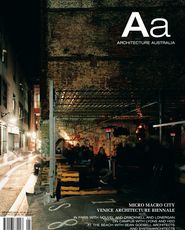
CAREY LYONNATIONAL PRESIDENT RAIA
Australian architects’ relationship with the suburbs has always been, and remains, fraught. This relationship has oscillated through extremes of hostility, ambivalence and celebration, resulting in varying levels of engagement and disengagement over time, particularly with suburban housing.
Within the current so-called McMansions debate, architects seem to be at one of the more remote points of disengagement. Why is this and what can be done about it?
A short analysis of recent histories illustrates this fluctuation between intimacy and rejection.
Through his 1960 book The Australian Ugliness, Robin Boyd beat the war drums at the suburbs in an effort to ward off their perceived evils. This gave weight to the proposition of the “ugly” suburbs and their preferable opposite, “good” design, which led to ventures such as the Small Homes service in Melbourne and an extensive architectural engagement in the burgeoning project home market. This in turn led to architect- and design-led initiatives such as the Pettit and Sevitt homes in Sydney and, later, Merchant Builders in Victoria.
In subsequent decades, at least in some Australian cities, this critique was replaced by an interest in the centrality of the suburbs in Australian life: a place for lives to be fully lived. Although in many sectors the body of work created out of this interest was received as mere suburban quotation under the rubric of postmodernity, it recognized something important in our expanded cities: “our house”.
As a high point in the engagement with the suburbs and suburban housing, this work eschewed the idea of architecture as the opposite of the suburbs (i.e. bad design/good design, ugly/beautiful paradigms) by proposing suburban life as something worthy, even noble, in its own right. From that point onwards, into the new century, this proposition has led to new levels of disengagement.
The edge of town, the suburban tract, seems to be Australian architects’ blind spot: not so much hidden from view as a hole or gap on the edge of our peripheral vision. This blind spot is due, in part, to our continued interest, even obsession, with the pre-eminence of the Arcadian house in our distinctly local landscape and, equally, an aversion to the realities of our highly urbanized culture, a culture which is, in fact, the more distinctly Australian reality. The upcoming exhibition in the Australian Pavilion at the Venice Architecture Biennale, which is covered extensively in this edition of Architecture Australia, further extrapolates this urban narrative.
Our disengagement also extends into the economic, market and construction realities of the house and land product. The delivery of suburban housing has become increasingly research-focused in terms of affordability, lifestyles, marketing and economies of scale – constructors can count the number of chippies’ staples used in each new house. The concept of mass production has more or less been conquered, and we are now moving to an idea of mass customization. Whereas architects have previously been leaders in mass production and prefabrication concepts, we need to engage with the concept of mass customization.
Perhaps we have also lost respect for new lifestyles that are emerging and demand our attention and interest. The dismissal of the suburbs as an illegitimate part of our built environment is often patronizing, while interesting lifestyles continue: McMansions – we’re livin’ it. New and strange models of housing are actively being developed in new suburbs, such as “warehouses” which can be instantly “renovated” into a “studio” style of living. Large homes on small blocks are replacing small homes on large blocks. These are just some of the new realities.
So what can architects do to re-engage? Firstly, move the focus of our vision so that these new realities come out from our blind spot. Stop thinking of engagement with the suburbs as a conservative acquiescence to the realities of an affluent aspirational society – something “ugly” and generic beyond the possibilities of the “beautiful” and the particular. Architects need to engage with the “influencers” in the mass housing market – the politicians, the developers, the constructors and the vast majority of Australians who are still deeply in love with a community-based suburban life.
Primarily we need to create strategies to add value through design. We need to get with the programme and develop new models, ones which respond to the mass market interest in our design culture, ones which are more environmentally sustainable, ones which work intelligently with the landscape, and ones that fit changing demographic needs and aspirations. We also need to explore ways to build these prototypes as a demonstration of new designs for the new realities, like a suburban Weissenhofsiedlung – a place for the tyre kickers and punters to inspect new product.
The RAIA is exploring ways to facilitate this re-engagement, and I would be interested in your views via president@raia.com.au.
CAREY LYON NATIONAL PRESIDENT RAIA















